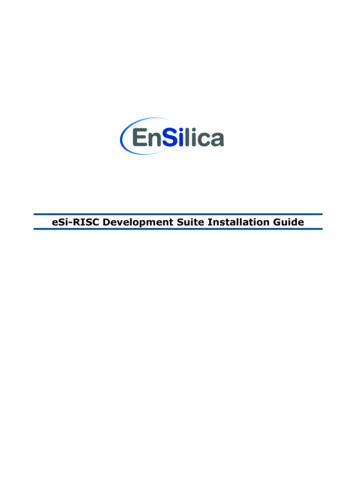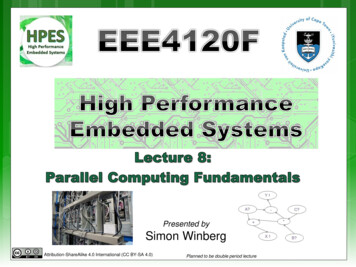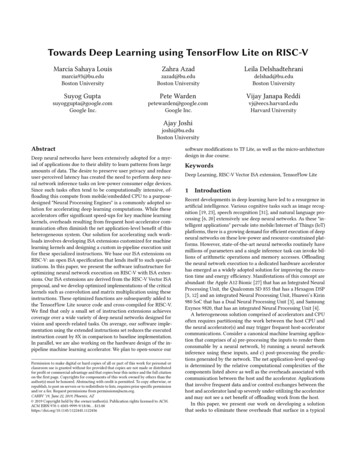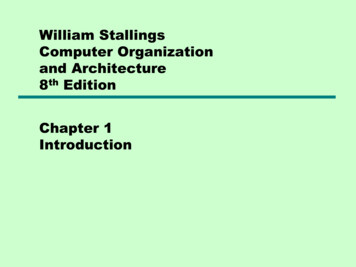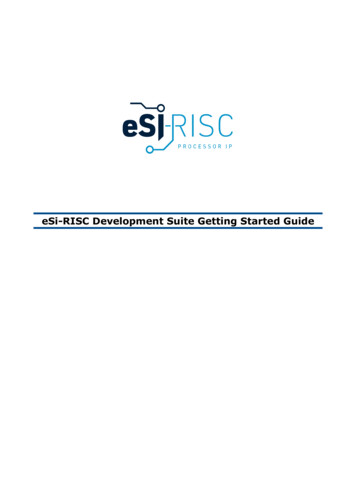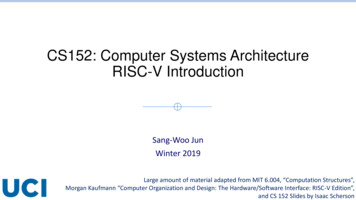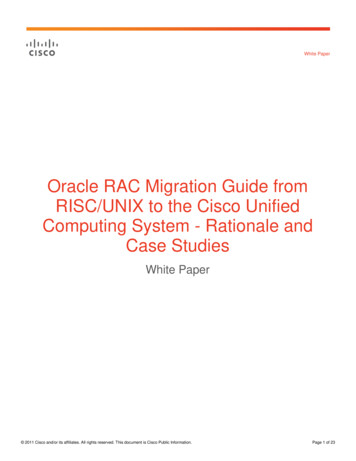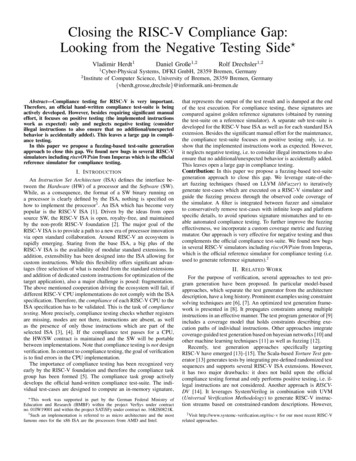
Transcription
Closing the RISC-V Compliance Gap:Looking from the Negative Testing Side?Vladimir Herdt1Daniel Große1,2Rolf Drechsler1,212Cyber-Physical Systems, DFKI GmbH, 28359 Bremen, GermanyInstitute of Computer Science, University of Bremen, 28359 Bremen, men.deAbstract—Compliance testing for RISC-V is very important.Therefore, an official hand-written compliance test-suite is beingactively developed. However, besides requiring significant manualeffort, it focuses on positive testing (the implemented instructionswork as expected) only and neglects negative testing (considerillegal instructions to also ensure that no additional/unexpectedbehavior is accidentally added). This leaves a large gap in compliance testing.In this paper we propose a fuzzing-based test-suite generationapproach to close this gap. We found new bugs in several RISC-Vsimulators including riscvOVPsim from Imperas which is the officialreference simulator for compliance testing.I. I NTRODUCTIONAn Instruction Set Architecture (ISA) defines the interface between the Hardware (HW) of a processor and the Software (SW).While, as a consequence, the format of a SW binary running ona processor is clearly defined by the ISA, nothing is specified onhow to implement the processor1 . An ISA which has become verypopular is the RISC-V ISA [1]. Driven by the ideas from opensource SW, the RISC-V ISA is open, royalty-free, and maintainedby the non-profit RISC-V foundation [2]. The major goal of theRISC-V ISA is to provide a path to a new era of processor innovationvia open standard collaboration. Around RISC-V an ecosystem israpidly emerging. Staring from the base ISA, a big plus of theRISC-V ISA is the availability of modular standard extensions. Inaddition, extensibility has been designed into the ISA allowing forcustom instructions. While this flexibility offers significant advantages (free selection of what is needed from the standard extensionsand addition of dedicated custom instructions for optimization of thetarget application), also a major challenge is posed: fragmentation.The above mentioned cooperation driving the ecosystem will fail, ifdifferent RISC-V CPU implementations do not comply with the ISAspecification. Therefore, the compliance of each RISC-V CPU to theISA specification has to be validated. This is the task of compliancetesting. More precisely, compliance testing checks whether registersare missing, modes are not there, instructions are absent, as wellas the presence of only those instructions which are part of theselected ISA [3], [4]. If the compliance test passes for a CPU,the HW/SW contract is maintained and the SW will be portablebetween implementations. Note that compliance testing is not designverification. In contrast to compliance testing, the goal of verificationis to find errors in the CPU implementation.The importance of compliance testing has been recognized veryearly by the RISC-V foundation and therefore the compliance taskgroup has been formed [5]. The compliance task group activelydevelops the official hand-written compliance test-suite. The individual test-cases are designed to compute an in-memory signature,? This work was supported in part by the German Federal Ministry ofEducation and Research (BMBF) within the project VerSys under contractno. 01IW19001 and within the project SATiSFy under contract no. 16KIS0821K.1 Such an implementation is referred to as micro architecture and the mostfamous ones for the x86 ISA are the processors from AMD and Intel.that represents the output of the test result and is dumped at the endof the test execution. For compliance testing, these signatures arecompared against golden reference signatures (obtained by runningthe test-suite on a reference simulator). A separate sub test-suite isdeveloped for the RISC-V base ISA as well as for each standard ISAextension. Besides the significant manual effort for the maintenance,the compliance test-suite focuses on positive testing only, i.e. toshow that the implemented instructions work as expected. However,it neglects negative testing, i.e. to consider illegal instructions to alsoensure that no additional/unexpected behavior is accidentally added.This leaves open a large gap in compliance testing.Contribution: In this paper we propose a fuzzing-based test-suitegeneration approach to close this gap. We leverage state-of-theart fuzzing techniques (based on LLVM libFuzzer) to iterativelygenerate test-cases which are executed on a RISC-V simulator andguide the fuzzing process through the observed code coverage ofthe simulator. A filter is integrated between fuzzer and simulatorto conservatively remove test-cases with infinite loops and platformspecific details, to avoid spurious signature mismatches and to enable automated compliance testing. To further improve the fuzzingeffectiveness, we incorporate a custom coverage metric and fuzzingmutator. Our approach is very effective for negative testing and thuscomplements the official compliance test-suite. We found new bugsin several RISC-V simulators including riscvOVPsim from Imperas,which is the official reference simulator for compliance testing (i.e.used to generate reference signatures).2II. R ELATED W ORKFor the purpose of verification, several approaches to test program generation have been proposed. In particular model-basedapproaches, which separate the test generator from the architecturedescription, have a long history. Prominent examples using constraintsolving techniques are [6], [7]. An optimized test generation framework is presented in [8]. It propagates constraints among multipleinstructions in an effective manner. The test program generator of [9]includes a coverage model that holds constraints describing execution paths of individual instructions. Other approaches integratecoverage-guided test generation based on bayesian networks [10] andother machine learning techniques [11] as well as fuzzing [12].Recently, test generation approaches specifically targetingRISC-V have emerged [13]–[15]. The Scala-based Torture Test generator [13] generates tests by integrating pre-defined randomized testsequences and supports several RISC-V ISA extensions. However,it has two major drawbacks: it does not build upon the officialcompliance testing format and only performs positive testing, i.e. illegal instructions are not considered. Another approach is RISCVDV [14]. It leverages SystemVerilog in combination with UVM(Universal Verification Methodology) to generate RISC-V instruction streams based on constrained-random descriptions. However,2 Visit http://www.systemc-verification.org/risc-v for our most recent RISC-Vrelated approaches.
RISCV-DV offers only very limited support for generation of illegalinstructions and thus is not suitable for comprehensive negative testing. In addition, the approach does not support the compliance testingformat and requires a commercial RTL simulator providing SystemVerilog (constrained-random features) as well as UVM support.[15] proposed coverage-guided fuzzing for verification of instructionset simulators. However, the approach is not compatible with thecompliance testing format, since it generates platform dependenttests in ELF format instead of providing platform independent testswritten in assembler (ASM), which also significantly reduces itsapplicability to different platforms. Furthermore, the approach doesnot support automated testing, as it requires manual inspection toavoid false negatives due to platform specific details.In addition, there are also formal verification approaches forRISC-V based on model checking. Notable are riscv-formal [16] andthe OneSpin 360 DV RISC-V verification app [17]. However, bothapproaches clearly target the verification of an implementation.Finally, [18] specifically considers compliance testing of RISC-V.It defines a test-suite specification mechanism and leverages constraint solving techniques to generate a comprehensive compliancetest-suite as counterpart to the hand-written official compliance testsuite. However, it also only focuses on positive testing and does notconsider negative testing aspects, such as illegal instructions.III. P RELIMINARIESA. RISC-VThe RISC-V ISA consists of a mandatory base integer instructionset, denoted RV32I, RV64I or RV128I with corresponding registerwidths, and various optional extensions denoted as single letters, e.g.M (integer multiplication and division), A (atomic instructions), C(compressed, i.e. 2 byte instructions), F and D (single and doubleprecision floating point) etc. Thus, RV32IMC denotes a 32 bit corewith M and C extensions. G denotes the IMAFD instruction set,hence RV32GC RV32IMAFDC. Each core has 32 general purposeregisters x0 to x31 (with x0 being hardwired to zero) and the floatingpoint (FP) extensions add additional 32 FP registers. Instructionsaccess registers (source: RS1 and RS2, destination: RD) and immediates to do their operation. Format and semantics (for the base ISAand extensions) are defined in the unprivileged ISA specification [1].In addition, the privileged (architecture) specification [19] covers further important functionality that is required for environmentinteraction and operating system execution. It includes differentexecution modes, in particular the mandatory Machine mode as wellas the Supervisor and User mode extensions with correspondingControl and Status Registers (CSRs) descriptions. CSRs are registersserving a special purpose, that form the backbone of the privilegedarchitecture description, such as MTVEC (stores the trap/interrupthandler address), MHARTID (read-only core id) and MSTATUS(main control and status register for the core).B. LLVM libFuzzerlibFuzzer is an LLVM-based state-of-the-art coverage-guidedfuzzing engine that proved very effective in finding several SWbugs [20]. It aims to create input data (binary bytestreams) in order tomaximize the code coverage of the SUT (SW Under Test). Therefore,the SUT is instrumented by Clang compiler to report code coverageto libFuzzer. Input data is transformed by applying a set of predefined mutations (shuffle bytes, insert bit, etc.) randomly. Input sizeis gradually increased (when coverage starts to saturate).Technically, libFuzzer is linked with the SUT, hence performs socalled in-process fuzzing, and allows to pass inputs to the SUT aswell as receive coverage information back through specific interfacecoverage information (instrumented by clang compiler)Phase A:Test-suiteGenerationmutate bytestreamcalledbyfuzzerCoverage1) Fuzzer(libFuzzer)Custom MutatorsDrop Bytestream(No New Coverage)Bytestream(Instructions)collect onnew coverageBytestreamTest-case TemplateBytestreamBytestream(Source t-suitecompile and runReferenceSimulatorcompile and runSimulators/CoresUnder TestTest-case Template(Pre-compiled ELF)pre-load into memoryuse specific ISA config.Inject Bytestreamand Executeclone priorexecutionSim. Engine Memory(Initial State)notify atexecutionCustom CoverageEncodingCustom CoverageSpecificationgeneratePhase B: Compliance Testingcompare signaturesTest Output(Signature)ok2) Filter(Static Analysis)combineTest-case(Source File)3) Simulatorremove ?generate once (per RISC-V ISA config)e.g. RV32I seperate setReference Output RV32IMC of ref. outputs(Signature)RV32GC,. per ISA config.Fig. 1. Overview: fuzzer-based approach for RISC-V compliance testingfunctions. For example, the SUT receives inputs through the LLVMFuzzerTestOneInput(const uint8 t *Data, size t Size) function.IV. F UZZING - BASED RISC-V C OMPLIANCE T ESTINGThis section presents our fuzzer-based approach for RISC-V compliance testing. We start with an overview.A. Approach OverviewFig. 1 shows an overview on our approach. Essentially, it consistsof two subsequent phases: first a fuzzer-based test-suite is generated(Phase A, shown on top of Fig. 1), then the test-suite is leveraged forcompliance testing (Phase B, shown on bottom of Fig. 1). Our generated test-suite follows the same format as the official compliancetest-suite and thus also generates signatures for compliance testing.However, in contrast to the official suite, which has a dedicated subsuite for each RISC-V ISA extension, we generate a single suitethat can be compiled and executed with any supported RISC-VISA (currently we support any configuration of RV32GC), sinceunsupported instructions should be considered illegal and result inan exception. Furthermore, due to the randomness of the fuzzingprocess, both phases can be continuously repeated, to achieve an evenmore comprehensive testing.Test-suite generation involves three main steps: 1) fuzzer, 2) filterand 3) simulator, that are repeated until the specified time (or memory) limit is reached. The fuzzer generates (random) bytestreams,which are interpreted as RISC-V instruction sequences, and passesthem to the filter that decides whether the bytestream is furtherprocessed or dropped. Essentially, the filter conservatively dropsbytestreams with infinite loops and platform specific details (testcases are available as source files and are compiled separately foreach target platform with custom definitions), to avoid spurioussignature mismatches. This is very important to enable a continuous and automated testing process, because the potential presenceof spurious mismatches would require manual analysis to confirmthat they are indeed spurious (to avoid missing bugs). In case thebytestream is dropped, no coverage information is returned to thefuzzer and hence the fuzzer considers that bytestream uninterestingand does not collect it. Otherwise, the bytestream is executed on thesimulator and coverage information is returned to the fuzzer. Thishappens automatically by compiling the simulator with Clang andusing the -fuzzer sanitizer (because we use LLVM libFuzzer, whichis compatible with Clang). For simulation, we provide a test-casetemplate, as RISC-V assembler (ASM) source file. As optimization,the test-case template is pre-compiled into an ELF and pre-loadedinto the simulator memory. Before each bytestream execution thesimulator is cloned to preserve the initial state.
To improve the fuzzing process we use a custom mutator andcoverage specification. The coverage specification is automaticallytransformed into a source file that is embedded into the simulatorand updated on every instruction execution.Next, we present more details on the test-case format (Section IV-B) and filter (Section IV-C) as well as the custom mutator(Section IV-D) and coverage encoding (Section IV-E).B. Test-case TemplateOur test-case template builds on the RISC-V compliance testingformat [5] to ensure that the generated test-suite is directly applicableto all platforms that support this standard format. It performs ageneric system initialization sequence (initialize core CSRs andregister a trap handler) and then enters the actual test-case body.Macros are used to mark the begin/end of code and data as well ashalt execution. The macros as well as compilation flags are platformspecific, thus we cannot rely on hardcoded absolute addresses toaccess memory or use as jump target (because code and data maybe stored at different addresses per platform).The test-case body starts by initializing all registers: x0 to x29are loaded from hardcoded memory values, x30 and x31 (chosenarbitrarily) are set to point into the middle of the data memory byusing a label. Thus, x0 to x29 have equal values among all platformsand hence can be used for comparable computations while x30 andx31 are platform specific but can be used as address for memoryaccesses. The data memory is large enough to support any additionalimmediate offset, i.e. [-2048, 2047].The test-case body ends by first incrementing x26 (an arbitraryregister to distinguish between cases where the test code executeswith/without exceptions) and then initiates the shutdown sequencethat will write back all register values (except x30 and x31 since theyhave platform specific values) to the data memory and halts execution(causing a signature dump). In case of an illegal instruction in thebytestream, control is transferred to the trap handler, which initiatesthe shutdown sequence (but bypasses the x26 increment).In-between start/end of the test-case body, the fuzzer generatedbytestream is injected. The template provides a list of jump instructions (to the body end) at this point that will simply be overwrittenwith raw memory declarations, e.g. .word 0x12345678, for eachword in the bytestream. The number of jump instructions in thetemplate is large enough for the bytestream to not exceed it.Please note, we also load and store the content of floating point(FP) registers alongside the normal registers. However, we conditionally guard it with the definition of riscv fdiv, which is set byGCC when selecting a RISC-V ISA (-march flag) with FP support.C. FilterThe filter works by performing an abstract local execution ofthe bytestream that traverses the local control flow and checksthe reachable instructions alongside. The abstract execution stateconsists of a program counter (PC), a mark (clean/dirty) for eachregister that indicates whether the register can be used as address fora memory access, and data structures to keep track of the controlflow to avoid loops. At the beginning PC is set to zero (i.e. pointingto the beginning of the bytestream) and all registers are marked dirtyexcept for x30 and x31 (since they are initialized with a label to thedata memory by the test-case, recall Section IV-B).The filter then repeats a fetch, decode and execute loop. Thus, itchecks whether the next instruction (based on PC) is compressed (thetwo least significant bits are not 11). Then, it decodes the instruction,increments PC by 4 (normal) or 2 (compressed) accordingly, and (abstractly) executes the decoded instruction. To avoid loops, the filteressentially checks that the same PC is not revisited. Furthermore, PCis not allowed to leave the local bounds of the bytestream (due toa jump/branch). A branch instruction forks the execution path, bycloning the abstract execution state S into ST and SF . The PC ofST is updated with the branch offset, which is relative to the currentPC and hence platform independent, accordingly (the PC of SF isalready set correctly to fallthrough to the next instruction). ST andSF are processed independently.The instructions JALR, [M,S,U]RET, WFI, EBREAK andSFENCE.VMA are forbidden (the bytestream is dropped if they arereachable on any path). The reason is that JALR and [M,S,U]RETperform a register/CSR based jump. WFI (Wait For Interrupt) mighthalt a processor causing non-termination (since no interrupt is coming). EBREAK can have a special semantic and SFENCE.VMA is aprivileged instruction that is often not implemented (which is not abug by itself but a deliberate decision). All (six) CSR instructions areforbidden too, due to highly platform dependent behavior of CSRs(we provide more details on the problem and potential solutionsin Section VI).Any instruction writing to a register RD, marks RD dirty. Aload/store instruction is forbidden if its address register is dirty.In addition, we also require that the immediate (which will beadded to the register address to obtain the final access address)is properly aligned, because the RISC-V ISA allows both alignedand unaligned load/store instructions (which would lead to spurioussignature mismatches).A path passes when reaching an illegal instruction (since the nextinstructions will not be reached due to the exception) or the end ofthe bytestream.For illustration Fig. 2 shows an example. The left side showsan ASM program, that represents the bytestream. Each instructionis prepended by it’s (local) address (for simplicity we assume allinstructions are non-compressed, i.e. are 4 byte long). The right sideshows the three possible control flow paths through this program,starting from the initial state. Each instruction execution (annotatedabove a state transition) results in a new state. The current PCand set of registers marked clear are shown below each state. TheASM program (bytestream) is accepted by the filter because allpaths are accepted. Please note, that the program contains a WFIinstruction which is in the forbidden category. However, the WFIhas no influence, since it is never reached on any path. Similarly, theADD instruction at address 12 that marks x30 dirty is not reached andhence the LW at address 28 succeeds. BLT and BEQ fork the activepath to continue at P CT 28, P CF 20 and P CT 16, P CF 28,respectively.Our filter currently supports the RV32GC ISA. Hence, the generated test-suite can be executed on any sub-ISA of RV32GC, such asRV32I, RV32IMC etc. To add a new instruction extension, the filterneeds to be extended as well. Otherwise, the filter will consider themas illegal instructions and let them pass unconditionally.D. Custom MutatorWe integrate a custom mutator to provide the fuzzer with valid instruction (opcode) patterns to increase the number and length of validinstructions. Our mutator is attached through the libFuzzer providedinterface and is called with equal probability to the existing mutators.Basically, the mutator moves through the bytestream instruction byinstruction (we use a 4 byte format) and injects valid opcodes, whilekeeping all other parameters randomized by the fuzzer. Please note,we only inject instructions that pass our filter (since the bytestreamwill be dropped otherwise). Besides avoiding instructions from theforbidden category, we only use small offsets for branch and jumpinstructions (might still be rejected by the filter but the probabilityis much smaller) and only inject load/store instructions that use
1234567890: ADD x31, x2, x34: JAL x2, 208: WFI12: ADD x30, x2, x316: BLT x30, x31, 1220: illegal24: BEQ x1, x2, -828: LW x5, -16(x30)//accept path//mark x31 dirty//mark x2 dirty, to PC 24//fobidden, drop bytestream//mark x30 dirty//fork, to PC 28:20//accept path//fork, to PC 16:28//require x30 cleanLW x30,-16(x30)initial stateintermediate statefinal state (of a path)ADD x31,x2,x3PC 0,{x30,x31}JAL x2,20PC 4,{x30}BEQ x30,x31,12 TLegendBEQ x1,x2,-8PC 24,{x30}TFPC 16,{x30}FpassPC 28, {x30}illegalpassPC 20, {x30}LW x5,-16(x30)passPC 28, {x30}Fig. 2. Left side shows an example RISC-V ASM program (for a bytestream with 32 byte) and right side shows the corresponding control flow paths25 2415 1412 117 603120 190000000 eADD: Regs[RD] Regs[RS1] Regs[RS2]3120 1915 1412 117 60xxxxxxxxxxxxx31/x30010xxxxx0000011I immRS1opcodeRDopcodeLW (Load Word): Regs[RD] Mem[Regs[RS1] I imm]Fig. 3. Format and semantic for the ADD and LW instruction. The opcodes are injected by our mutator, the other fields remain randomized (each random bit isdenoted with an x). Special constraints are used (such as setting RS1 to x30 or x31 for LW) to pass our filter.x30 or x31 as address register. For illustration Fig. 3 shows theinstruction format and semantic for ADD and LW. When injectingthe ADD instruction, the RS1, RS2 and RD fields remain random,but all opcode fields are overwritten by the mutator, thus making theinstruction a valid (though randomized) ADD. Similarly, for the LWinstruction, though here rs1 is always set to either x30 or x31 registerto pass the filter.E. Custom CoverageBy default the fuzzing process is guided by code coverage emittedby the simulator that executes the bytestreams. We consider twoadditional coverage metrics.The first is a hash-based coverage that is simple, generic and scalable. Basically it computes a small hash value of the instruction wordand considers every different hash value as new coverage. This addsa significant amount of variance and randomness to the generatedtest-suite. Technically, we use a C std::hash uint32 t fn hashfunction. Then, every fetched instruction is passed through a (large)switch statement: switch (fn(fetched word) % N). N is the configurable number of hashes to use. Inside the switch statement we genervolatile (””);ate N cases, for i {0, ., N }, as case i: asmbreak;. The asmvolatile statement ensure that the cases arenot removed by the compiler.The second coverage reasons about structure and values ofRISC-V instructions. It is provided through an external specificationfile. It can strengthen the fuzzer in the field of positive testingby collecting further test-cases with valid instructions. Basically,we use a small set of rules such as: 1) RD x0, 2) RD6 x0, 3)RD RS1, and 4) RD6 RS1. Each rule is applicable to instructionsthat have the corresponding fields and defines a coverage point withthe rules condition, for example if (decoded instruction.opcode ADD && decoded instruction.RD x0) asmvolatile ;for rule 1 and opcode ADD (all matching opcodes are enumerated)3 .The first and second rule are due to the RISC-V hardwired x0register. The third and fourth are useful to check for effects wherethe update order is not correct. Similarly, we have a rule for threeregisters (all equal, all not equal, etc). Finally, we use value rulesReg[RS1] OP Reg[RS2] with OP { , 6 , , } and Reg[RS*] {M IN, M AX, 1, 0, 1}, and similar rules for immediates.V. E XPERIMENTSWe have implemented our fuzzer-based approach for RISC-Vcompliance testing and evaluated its effectiveness on a set of RISC-Vsimulators. As foundation for the fuzzing process we use the 323 We use a slightly optimized implementation by using switch case statementfor the opcode and grouping all rules below the opcode.bit (instruction set) simulator of the open source RISC-V VP [21],[22]. Next, we first provide more information on the fuzzer-basedtest-suite generation process (Section V-A) and then present resultson the compliance testing evaluation (Section V-B). All experimentshave been performed on a Linux system with an Intel Core i5-7200Uprocessor.A. Test-suite GenerationFig. 4 shows execution information for four different fuzzingconfigurations (v0 to v3) that use different coverage metrics: v0uses only code coverage of the ISS; v1 adds the custom coveragerules (structural and value metrics) to v0 (additional 2281 coveragepoints); v2 and v3 add hash coverage with 4096 and 16384 coveragepoints to v1, respectively. Fig. 4 shows how the number of testcases grows compared to the number of fuzzer executions (i.e. overtime). The runtime is fixed to 30 minutes for each configuration. Weuse a 64 byte input length limit for the fuzzer and configured it toincrease the input length more slowly (-len control 10000). It canbe observed that the number of test-cases grows very rapidly in thefirst quarter and then gradually saturates (please note the logarithmicscale on the X axis). The average executions per second are at 45,873with the minimum at 12,302 and maximum at 68,873. To achievethis high performance, it has been particularly important to precompile and pre-load the test-case template and use a small simulatormemory size (32 KB). The highest measured memory consumptionon our evaluation system has been 1063 MB for configuration v3.The coverage metric is very important since it has immediate impacton the fuzzing process. First, on the performance, since the coverageneeds to be tracked (which costs time) and it influences how fastthe fuzzer increases the input size (every time the coverage starts tosaturate), which in turn increases the probability that our filter dropsmore inputs. Second, on the number of generated test-cases, sincethe fuzzer only collects test-cases that increase coverage. For thefollowing compliance testing evaluation we use the v3 configuration.B. Compliance TestingWe consider five different RISC-V simulators, which all support the RISC-V compliance testing format, in this evaluation4 :riscvOVPsim, Spike, VP, GRIFT and sail-riscv. riscvOVPsim [5] (seethe riscv-ovpsim folder) is the reference simulator for compliance4 We also briefly evaluated the rocket and Ibex cores, since they are listed astargets in the compliance testing repository. Both (RTL) cores can be compiledinto a (C ) simulator using verilator. However, the rocket simulator hadproblems with the compliance testing format (it failed every basic RV32I test)and the Ibex simulator stopped on the first exception (e.g. illegal instruction)without dumping a signature, which makes it not applicable in combination withnegative testing. Thus, we omitted these cores from the evaluation.
1400012000number of generated test-casesTABLE IN UMBER OF SIGNATURE MISMATCHES AGAINST riscvOVPsimv3: number test-cases 13540v2: number test-cases 8531v1: number test-cases 4066v0: number test-cases 68910000RISC-V h/GRIFT1241047141VP uses a wrong mask for the ECALL instruction in thedecoder which allows an invalid instruction to be decoded andexecuted as an ECALL. In addition, reserved non-hint compressed instructions, e.g. ”c.lwsp x0, 0(sp)”, are erroneouslynormally expanded and executed without causing an illegalinstruction exception5 . GRIFT updates the RA register on an invalid jump (targetaddress not 32 bit aligned on RV32I) before triggering anillegal instruction exception (which is incorrect, since illegal instruction should have no side effects). Furthermore, theRV32IMC compliance testing target has been incorrectly configured to RV32GC, thus floating point and atomic instructionsare erroneously accepted as well. In addition, similar to VP,reserved non-hint compressed instructions are also erroneouslyaccepted as legal instructions. Finally, we also found the bugthat SC.W instruction performs memory access even withoutpending LR.W reservation (which was the only bug found bythe official compliance test-suite). sail-riscv has several incomplete decoder checks that causeinvalid instructions to be accepted as valid ones. Some inputs crashed sail-riscv, others led to non-termination (whichindicates that
the OneSpin 360 DV RISC-V verification app [17]. However, both approaches clearly target the verification of an implementation. Finally, [18] specifically considers compliance testing of RISC-V. It defines a test-suite specification mechanism and leverages con-straint solving techniques to generate a comprehensive compliance


